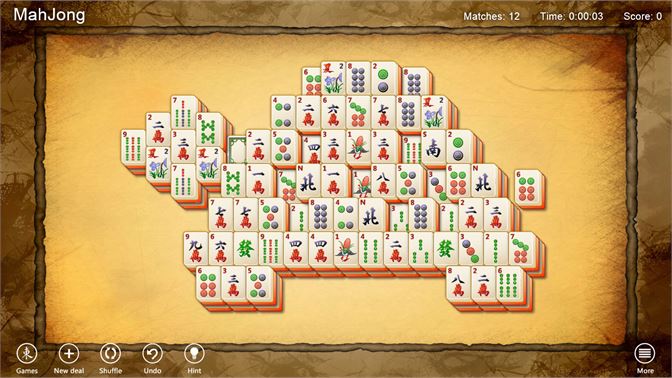- How To Shuffle The Tile Game On Mac Download
- How To Shuffle The Tile Game On Mac X
- How To Shuffle The Tile Game On Mac Free
- How To Shuffle The Tile Game On Mac Pro
Mahjong solitaire (also known as Shanghai solitaire, electronic or computerized mahjong, solitaire mahjong or simply mahjong) is a single-playermatching game that uses a set of mahjong tiles rather than cards. It is more commonly played on a computer than as a physical tabletop game.
Its name comes from the four-player game mahjong, but it is played entirely differently.
Sep 28, 2020 Play a song, album or playlist. Tap the song that's playing at the bottom of your screen. In the screen that appears, tap the Playing Next icon in the bottom right-hand corner. In the top right-hand corner of the Playing Next screen, you can: Tap the Shuffle button to turn shuffle on or off. Find two IDENTICAL IMAGES and tap on to connect them. Tiles can be connected with up to 3 STRAIGHT LINES where there is no other tile blocking the line path. Use HINT button to reveal a connectable.

Play[edit]
The 144 tiles are arranged in a special four-layer pattern with their faces upwards. A tile is said to be open or exposed if it can be moved either left or right without disturbing other tiles. The goal is to match open pairs of identical tiles and remove them from the board, exposing the tiles under them for play. The game is finished when all pairs of tiles have been removed from the board or when there are no exposed pairs remaining.

Tiles that are below other tiles cannot be seen. But by repeated undos or restarts which some programs offer, one gradually gets more and more information. Sometimes, tiles are only partially covered by other tiles, and the extent to which such tiles can be distinguished depends on the actual tile set.
Mathematical analysis[edit]
Playing Mahjong solitaire optimally in the sense to maximize the probability of removing all tiles is PSPACE-complete, and the game gets NP-complete when looking below tiles is allowed.[1] It has been proven that it is PSPACE-hard to approximate the maximum probability of removing all tiles within a factor of , assuming that there are arbitrarily many quadruples of matching tiles and that the hidden tiles are uniformly distributed.[2] The perfect-information version of this puzzle is where the player knows, before the game starts, the position of every tile. In this case, however, it is NP-complete to decide whether all tiles can be removed.[1]
A sample of games with the default layout, 'the turtle', revealed that between 2.95 and 2.96 percent of the turtles cannot be solved even if looking below tiles is allowed.[3]
Variations[edit]
Mahjong solitaire can be played using genuine tiles and a special wooden frame for set-up. Usually though, it is played in an electronic form as a computer game. This removes the tedium of set-up and the temptation to cheat. Some electronic Mahjong solitaire games offer extra options, such as:
How To Shuffle The Tile Game On Mac Download
- Shuffling the tiles[4]
- Changing the tile set and patterns from the traditional tiles to flowers, jewels or other items that may be easier to match up at a glance
- Playing a series of different layouts with varying levels of difficulty (usually given Chinese-looking names such as 'the ox' or 'the snake')
- Adding 'wildcard tiles' and other tiles that have special functions.
These games often have a time limit which is sometimes optional. Most also offer hints or undo options which provides the ability to have a match found for the player or to backtrack and undo already made moves. Additionally, most implementations of the game arrange the tiles in such a way that the game is solvable in at least one way.
Mahjong solitaire can be played either solo or with a partner, in which case the aim is to accumulate the most pairs, to be the last one to match a pair, or to score the most points. Points are gained for each pair removed, with bonus points for removing matched pairs in sequence or removing pairs in sequence that are parts of sets. Using traditional mahjong tiles, the sets include the dragons, the flowers, the seasons, and the winds. The winds are usually worth the most bonus points when paired individually, but the most bonus points are achieved by matching all of the seasons followed by all of the flowers (or vice versa).
With the advent of online gaming, some computer mahjong games offer 'clash' style player vs player challenges where each opponent solves the same board and shuffle, and the best score wins.[citation needed]
Some implementations offer to shuffle the tiles when there are no exposed pairs remaining, making it almost always possible for the player to complete the game.
Computer game history[edit]
The computer game was originally created by Brodie Lockard in 1981 on the PLATO system and named Mah-Jongg after the game that uses the same tiles for play. Lockard claims that it was based on a centuries-old Chinese game called 'the Turtle'.[5] There is a children's game in China named 拆牌龜 ('Demolish the Tile Turtle') of unknown age.[6] The computer game was released for free and was played using a CDC-721 touch screen terminal. Control Data Corporation released a new version as a paid online game in 1983. The first version remained available for free.
However, it was Activision's release of Shanghai in 1986 for the IBM Personal Computer, Amiga Computer, Macintosh, Atari ST and Apple IIgs that popularised the game.[citation needed] The Macintosh version was created by Brodie Lockard (programming and graphics) and the Apple IIGS version was ported from the Macintosh by Ivan Manley with Brad Fregger as the producer. The game became very successful, and around 10 million copies were sold. It has been ported to many different platforms. The name 'Shanghai' was trademarked by Activision. A similar game, known as Gunshy, was also released in 1987 for the Macintosh.
As the game is based on mahjong tiles, some confusion arose with the 4-player mahjong game. Although the name mahjong solitaire is generally accepted, other names include The Turtle as well as brand names Shanghai Solitaire,Taipei, Kyodai and Moraff's.
How To Shuffle The Tile Game On Mac X
A version of this game was also included in the Microsoft Entertainment Pack for Windows 3.x in 1990 and went by the name Taipei. It was subsequently included in the Best of Windows Entertainment Pack. Premium editions of the Windows Vistaoperating system and Windows 7 include a version of the game known as Mahjong Titans (known in Vista build 5219 as Shanghai Solitaire).[7]
How To Shuffle The Tile Game On Mac Free

Mahjong Solitaire was added to Clubhouse Games: 51 Worldwide Classics for Nintendo Switch.[8][9]
How To Shuffle The Tile Game On Mac Pro
See also[edit]
- Shisen-Sho, another solitaire game with Mahjong tiles
- Crazy Quilt (solitaire), a solitaire card game where cards are removed from the edges of a grid
- Other Solitaire games, especially Patience, or solitaire with cards
References[edit]
- ^ abhttp://www.ics.uci.edu/~eppstein/cgt/hard.html Eppstein's page on computational complexity of games.
- ^Condon, Anne; Feigenbaum, Joan; Lund, Carsten; Shor, Peter (1997). 'Random debaters and the hardness of approximating stochastic functions'. SIAM Journal on Computing. 26 (2): 369–400. CiteSeerX10.1.1.57.936. doi:10.1137/S0097539793260738.
- ^http://www.math.ru.nl/~debondt/mjsolver.html Solitaire Mahjongg solver.
- ^In these 3 the tiles can be shuffled, but not always
- ^Fregger, Brad (1998). Lucky that way. pp. 69–70. ISBN1-887472-56-8.
- ^簡而清,《開檯》,1988,博益,第九版. p.151. ISBN962-17-0088-4. Reprinted 1999,一本堂. ISBN978-962-17-4906-2.
- ^Paul Thurrott (2010-10-06). 'Microsoft Windows Vista Build 5219 (Community Technical Preview 1) Review | Product Review content from Paul Thurrott's SuperSite for Windows'. Winsupersite.com. Archived from the original on 2013-10-04. Retrieved 2013-06-29.
- ^'Nintendo Shares A Handy Infographic Featuring All 51 Worldwide Classic Clubhouse Games'. Nintendo Life. Retrieved 2020-07-21.
- ^'Nintendo Reveals The Most Popular Games In Clubhouse Games: 51 Worldwide Classics'. Nintendo Life. Retrieved 2020-07-21.